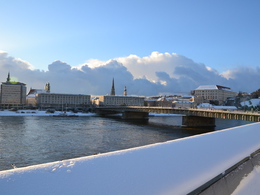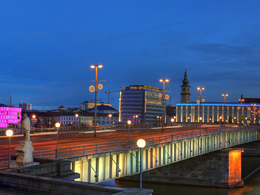Nibelungen Bridge
Linz, Oberösterreich, Österreich
Nibelungenbrücke
4020 Linz
4020 Linz

The Nibelungenbrücke in Linz connects the inner city and Urfahr district.
Historical background:
Having spent part of his school years and youth in Linz, Hitler subsequently entertained visions of giving the city a facelift. His plans hinged on monumental buildings on the banks of the Danube, an opera house and a museum close to the city centre and an avenue leading up to a new railway station in the south. A large architectural model of the city claimed Hitler’s attention until shortly before his death. Of these megalomaniac projects only a few have been realized. The Nibelungen Bridge was opened to traffi c in late 1940; work on the bridge necessitated two new buildings on the south side (the Finanzgebäude Ost and West) and the Wasserstraßenamt (today’s Heinrich Gleißner House). Construction work was largely in the hands of POWs and involved the use of materials produced at the Mauthausen complex of concentration camps. After the war the bridge spanned the demarcation line between the U.S. and the Soviet occupation zones. The Allied checkpoints on the Bridge shaped everyday life until 1953. A plaque seeks to keep the memory alive of the Sudeten Germans who came to Linz in 1945 after being expelled from Czechoslovakia.
4020 Linz
Web stadtgeschichte.linz.at/denkmal/Def…
https://stadtgeschichte.linz.at/denkmal/Default.asp?action=denkmaldetail&id=3070
- open to the public
Accessibility / arrival
Linz Linien: 1, 2, 3, 4, 50 - Hauptplatz
Please get in touch for more information.



